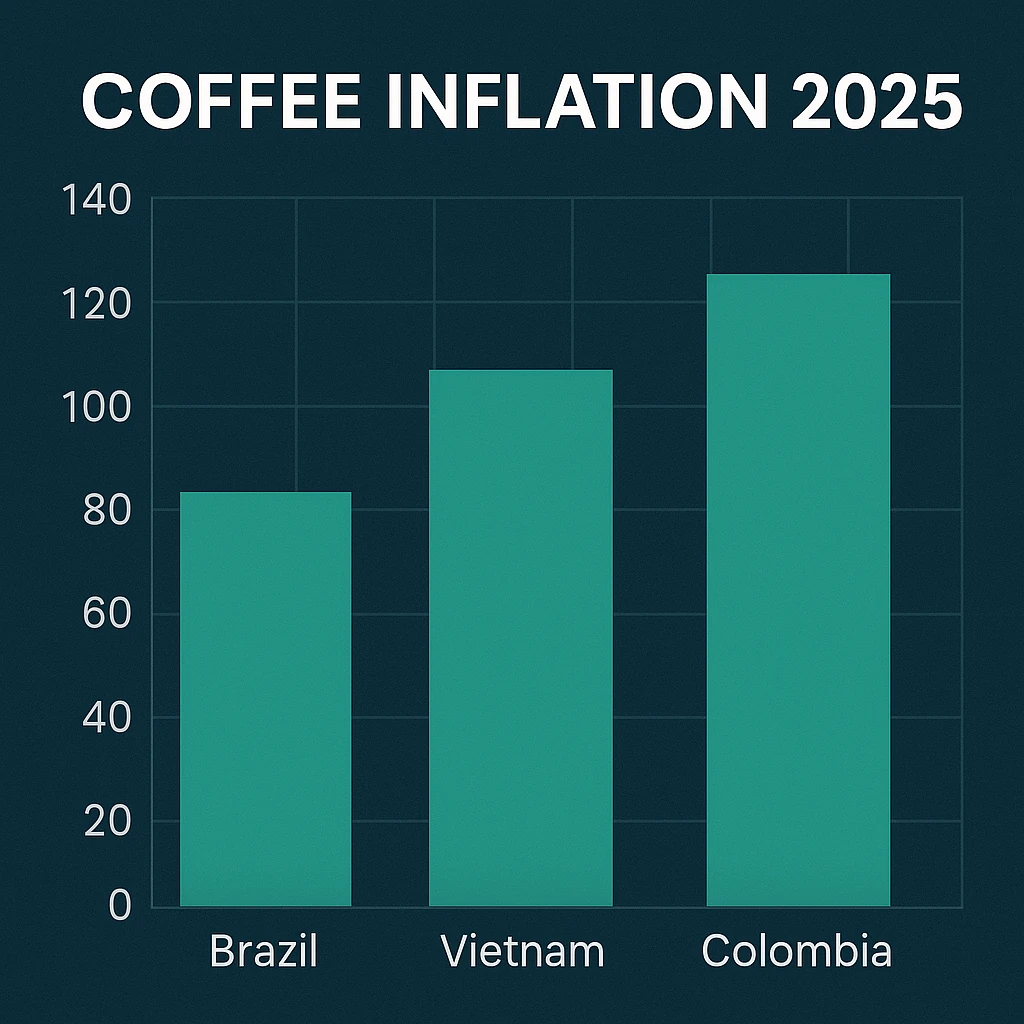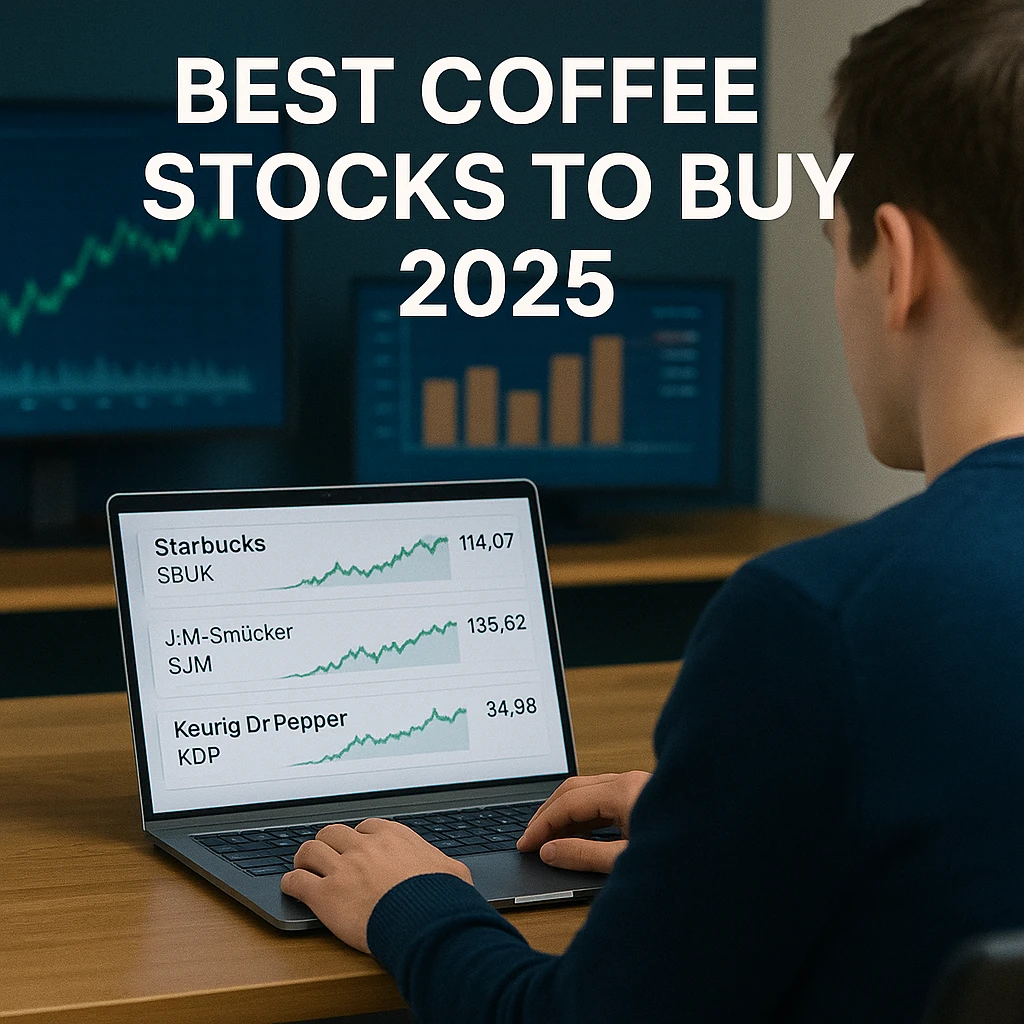
Why Coffee Prices Are Soaring in 2025 — and 3 Commodity Stocks That Could Perk Up
Coffee is waking up the markets this year, and traders want to know why coffee prices are soaring in 2025 and what it means for portfolios. A mix of weather shocks across key producers, tighter supplies of both arabica and robusta, logistics bottlenecks, and a still-sticky inflation backdrop has pushed futures higher and retail prices up with them. In this article, we’ll outline the biggest drivers behind the surge, how it fits into the wider cycle of rising commodity prices, and the three coffee-adjacent stocks that could benefit if momentum continues.
Key Points
- Supply strains: weather variability and crop disease risks in Brazil, Colombia, and Vietnam are tightening arabica/robusta availability.
- Logistics & costs: shipping reroutes and higher freight/insurance keep delivered prices elevated, feeding into coffee inflation 2025.
- Macro pulse: a firm USD, sticky services inflation, and broad commodity bid sustain upside volatility in KC futures.
- Trading angle: momentum/mean-reversion setups in KC1! plus downstream plays in inputs, processing, and branded beverages.
- What’s next: we’ll highlight three commodity-linked stocks that could perk up if coffee strength persists.
Global Coffee Market Overview: Why Prices Are Soaring in 2025
Coffee futures have climbed sharply through 2025, catching even seasoned commodity traders off guard. The surge reflects a perfect storm of tight global supply, erratic weather, and stubborn inflation pressures across major producing regions. In Brazil—the world’s largest coffee exporter—unexpected frosts and drought conditions reduced arabica yields. Meanwhile, Vietnam and Indonesia, key robusta suppliers, have battled erratic rainfall and fertilizer shortages, putting additional stress on global inventories.
As a result, coffee futures (KC=F) on the Intercontinental Exchange (ICE) are now trading near multi-year highs. The rally has pushed wholesale costs higher for roasters and food chains alike, contributing to what many analysts now call “coffee inflation 2025.” The impact extends beyond your morning brew—coffee’s price climb has become a bellwether for rising commodity prices more broadly, as soft commodities join metals and energy in leading the inflation cycle.
Inflation and Currency Pressures Add Fuel to the Fire
Beyond weather issues, macroeconomic forces are magnifying the coffee rally. Persistent inflation in food and energy has increased input costs for every stage of production—from fertilizers and transport to packaging. Meanwhile, the strong U.S. dollar has complicated trade dynamics for exporters, who receive fewer local-currency profits per pound sold abroad. These combined pressures have reinforced the uptrend visible on global commodity markets throughout 2025.
The latest data from Statista’s coffee market reports show global coffee consumption is expected to exceed 175 million 60-kg bags in 2025—an all-time high. Yet production is lagging, resulting in a projected deficit that analysts say could persist into 2026 if weather risks continue. This supply-demand imbalance has drawn investor attention toward both futures contracts and related commodity-linked equities.
Deep Dive: Supply Shocks, Freight Bottlenecks, and “Coffee Inflation 2025”
To understand why coffee prices are soaring in 2025, follow the chain from farm gate to café cup. Weather variability has trimmed yields in Brazil’s arabica belt and disrupted robusta flows from Vietnam, while higher input costs (fuel, fertilizer, labor) filter through every layer of the value chain. Add shipping reroutes and elevated insurance, and you get compounding cost pressure that ends up on grocery shelves and café menus—classic coffee inflation 2025.
Key Pressure Points (Farm → Cup)
- Yield risk: Drought/frost cycles reduce arabica supply; erratic rainfall crimps robusta output.
- Inputs: Fuel & fertilizer costs lift farm and processing breakevens; packaging adds another layer.
- Logistics: Vessel delays, reroutes, and higher insurance elevate delivered prices.
- FX & macro: Strong USD complicates producer margins; sticky services inflation keeps costs firm.
Track the benchmark contract here: KC=F (Coffee Futures), compare with broader commodity dashboards, and review basics on commodity investing. For context and headlines, see Reuters or Bloomberg.

How This Affects Traders and Investors
For active traders, softs like coffee can lead broader rising commodity prices cycles—use momentum and mean-reversion rules on KC while watching USD and freight indices. For investors, downstream equities (roasters, bottlers, diversified ags) may gain if cost pass-through sticks and volumes hold. If you prefer structured strategies, review our primers on day vs. swing trading, metals correlations via the silver rally playbook, and cross-asset hedges in the crypto & metals guide.
Deep Dive: Currency, Substitutes, and Cross-Commodity Signals
Coffee doesn’t trade in a vacuum. A firm U.S. dollar (USD) can pressure emerging-market producers, while broader commodity baskets influence roaster hedging behavior and retailer pass-throughs. When softs like coffee rally alongside a broad commodities bid, the odds of sustained pricing power increase—especially if substitute inputs (sugar, cocoa, packaging) are also elevated. Watching cross-signals helps explain why coffee prices are soaring in 2025 and whether momentum has more room.
Chart shows a broad commodity basket (DBC) that often trends with softs, metals, and energy. Strength here can confirm inflationary pressure across inputs that touch coffee production and distribution.
Signals to Monitor
- USD Index (DXY): A stronger USD can weigh on producer revenues; sharp USD pullbacks may fuel commodity spikes.
- Freight & Insurance: Route disruptions and premiums raise delivered bean costs—watch global shipping updates.
- Substitutes & Complements: Sugar, cocoa, packaging, and energy rises compound café and CPG pricing decisions.
- Term Structure: Backwardation in coffee futures can signal tight nearby supply and aggressive spot demand.
For benchmarks and definitions, see commodity basics. For dashboards and headlines, compare MarketWatch commodities, Reuters, and Bloomberg.
Insights & 2025–2026 Outlook: Who Could Perk Up if Coffee Stays Hot
Putting it all together, the forces behind why coffee prices are soaring in 2025—tight supply, higher logistics costs, and sticky inflation—create a lane for select commodity-linked equities. The edge goes to diversified ag players and scaled roasters/solutions providers that can hedge raw inputs and pass costs through to customers without losing volume. Below are three names to watch for momentum and operational leverage if the trend persists.

1) Archer-Daniels-Midland (NYSE: ADM)
- Thesis: Diversified ag origination, processing, and merchandising with robust hedging capabilities; exposure to softs, including coffee supply chains.
- Why it could perk up: Elevated futures and active basis trading can support merchandising margins when volatility is high.
- Watch: Crush margins, segment mix, working-capital swings, and any guidance tied to soft-commodity volatility.
- Risks: Mean-reversion in coffee prices; FX; liquidity/credit risk in trading counterparties.
2) Bunge Global (NYSE: BG)
- Thesis: Global agribusiness with origination/logistics reach across key crop flows; proven risk management through cycles.
- Why it could perk up: Dislocations in softs and freight often open up basis/arbitrage opportunities across the network.
- Watch: Volume trends in coffee-adjacent regions, freight costs, and forward hedging disclosures.
- Risks: Weather in LatAm, regulatory/export policy shifts, shipping bottlenecks normalizing faster than expected.
3) Westrock Coffee (NASDAQ: WEST)
- Thesis: Integrated coffee/tea extracts and beverage solutions to CPGs, QSRs, and retailers; scale and contracts aid cost pass-through.
- Why it could perk up: Higher input prices can expand revenue and, with disciplined procurement, preserve gross margin dollars.
- Watch: Contract pricing cadence, mix into extracts/RTD, and commentary on hedging/coverage ratios.
- Risks: Small/mid-cap execution risk, customer concentration, sensitivity to consumer demand.
| Scenario | Coffee Prices | Implication |
|---|---|---|
| Bull: Weather tightness + weak USD | New highs or sustained backwardation | ADM/BG merchandising tailwinds; WEST revenue/price uplift; watch volume elasticity. |
| Base: Elevated, choppy range | Sideways with high volatility | Trading and hedging drive steady results; stock selection favors disciplined operators. |
| Bear: Weather relief + freight normalization | Pullback toward multi-year averages | Mean-reversion risk to commodity plays; rotate to defensives or broader equity indices. |
Want a step-by-step approach to trading elevated commodities? Revisit our day vs. swing trading guide, check metals correlations in the silver rally strategy, and build resilience with our diversified crypto & metals portfolio guide.
FAQs About Rising Coffee Prices and Inflation Investing
Why are coffee prices so high in 2025?
Coffee prices are soaring in 2025 due to a mix of severe weather in top-producing nations like Brazil and Vietnam, higher shipping costs, fertilizer shortages, and persistent inflation in food and energy markets. Together, these pressures have created a global supply imbalance that continues to drive prices higher across both arabica and robusta varieties.
Will coffee prices keep rising through 2026?
Analysts expect volatility to remain elevated. If weather normalizes and shipping routes stabilize, prices could moderate; however, persistent inflation and rising demand from emerging markets suggest that the long-term trend remains firm. Investors tracking soft commodities may see opportunities in select ag and beverage equities during pullbacks.
Which coffee or commodity stocks benefit from higher prices?
Large-scale players like Archer-Daniels-Midland (ADM), Bunge Global (BG), and Westrock Coffee (WEST) have diversified operations that can hedge raw-input volatility and capture upside from sustained high prices. Each benefits differently—from logistics and trading margins to contract pass-through pricing in beverage solutions.
Is coffee a good inflation hedge?
Coffee, like many soft commodities, often rises during inflationary cycles when the cost of goods and shipping increases. While it’s not a perfect hedge, exposure through futures or diversified commodity ETFs can provide partial protection against purchasing power erosion—especially when coupled with other inflation-sensitive assets such as metals and energy.
How can traders profit from short-term coffee volatility?
Traders can use momentum setups on KC1! contracts, pair coffee trades with USD index positions, or hedge with correlated assets like sugar and cocoa. For tactical execution, review our day vs. swing trading guide to balance leverage and risk management.
Conclusion: Brewing Opportunities in a Tight Market
The why coffee prices are soaring in 2025 story is a case study in how global supply chains, macro trends, and inflation interact. With limited supply growth, continued logistics challenges, and resilient consumer demand, prices may stay firm into 2026. Traders should monitor both futures charts and commodity equities for momentum signals and cross-market divergences.
For a deeper look at hedging and cross-asset positioning, explore our guides on silver rally trading signals and diversified crypto and metals investing.
Whether you’re a long-term investor or short-term trader, understanding the fundamentals behind rising commodity prices helps you adapt quickly and capture the next wave of market opportunity.

Pauline Lei
Commodity and market analyst at TradeStockAlerts.com. Pauline follows the intersection of agriculture, inflation, and global commodities, offering insights on how shifts in softs like coffee, sugar, and cocoa affect traders and investors. Her work connects macroeconomic forces to actionable strategies—helping readers navigate the volatility of modern markets with clarity and data-driven perspective.